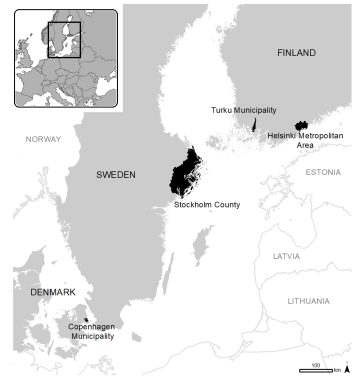Pandemic urban resilience in the Nordic context: a cross-city analysis on associations between outdoor recreation and green infrastructure
Nora Fagerholm, Department of Geography and Geology, University of Turku
Recent empirical research has confirmed the importance of green infrastructure and outdoor recreation to urban people’s well-being during the COVID-19 pandemic. However, only a few studies provide cross-city analyses. We analyse outdoor recreation behaviour across four Nordic cities ranging from metropolitan areas to a middle-sized city. We collected map-based survey data from residents (n = 469–4992) in spring 2020 and spatially analyse green infrastructure near mapped outdoor recreation sites and respondents’ places of residence. Our statistical examination reveals how the interplay among access to green infrastructure across cities and at respondents’ residential location, together with respondents’ socio-demographic profiles and lockdown policies or pandemic restrictions, affects outdoor recreation behaviour.
Five main messages from our results are:
- During the first wave of the COVID-19 pandemic, in the larger cities outdoor recreation took place relatively closer to residence and with less available urban green infrastructure.
- People in Stockholm increased visits to sites offering relatively greener outdoor experiences, influenced by the type of social distancing policies and the availability of green infrastructure to safely recreate.
- Low green infrastructure availability at the place of residence seems to encourage people to seek outdoor recreation experiences further away, and vice versa.
- As an exception, those working remotely due to COVID-19 did not generally seek outdoor recreation experiences in green or blue spaces although living in surroundings with relatively lower availability of green infrastructure.
- Specific socio-demographic groups sought outdoor recreation experiences during COVID-19 at a notable distance from their residence (young in Copenhagen; elderly and unemployed in Stockholm; young and unemployed in Turku).
The results highlight that for pandemic resilience, the history of Nordic spatial planning is important. To support well-being in exceptional situations as well as in the long term, green infrastructure planning should prioritise nature wedges in and close to cities and support small-scale green infrastructure.

Figure: The four study areas (black) within the three countries (grey). Inset shows location within Europe.
Fagerholm, N., Samuelsson, K., Eilola, S. et al. (2022). Analysis of pandemic outdoor recreation and green infrastructure in Nordic cities to enhance urban resilience. npj Urban Sustainability 2, 25. https://doi.org/10.1038/s42949-022-00068-8.
Photo credit: Vesa Arki
